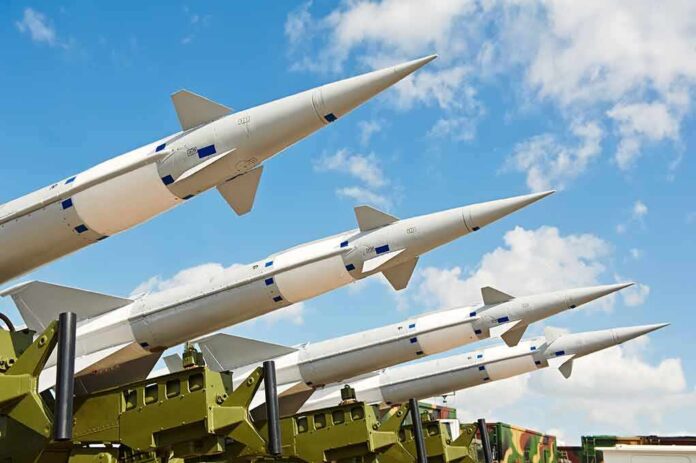Russia’s mass production of the Mach 10 hypersonic Oreshnik missile capable of delivering nuclear payloads across 3,425 miles threatens to render America’s missile defense systems obsolete and radically alter the strategic balance of power in Europe.
Key Takeaways
- Russia has begun full-scale production of the Oreshnik hypersonic missile, capable of speeds up to Mach 10 and ranges of 3,425 miles, putting European and western U.S. targets within reach
- President Putin claims the missile can evade any U.S. defense system and has proven its effectiveness in combat after being used against a defense facility in Dnipro, Ukraine
- The mobile-launched missile carries multiple independently targetable reentry vehicles (MIRVs) for both nuclear and conventional payloads
- Western officials have downplayed the missile’s significance, suggesting Russia possesses limited quantities despite Putin’s mass production announcement
- The development comes amid the collapse of the Intermediate-Range Nuclear Forces Treaty, potentially triggering a new arms race
Putin Announces Mass Production of “Unstoppable” Weapon
President Vladimir Putin has declared that Russia is now mass-producing its latest hypersonic weapon, the Oreshnik missile, after its successful battlefield debut in Ukraine. The solid-fuel, mobile-launched intermediate-range ballistic missile represents a significant advancement in Russia’s strategic arsenal, with Putin explicitly touting its ability to overcome Western defense systems. The missile’s operational deployment marks a troubling escalation in weapons technology as Russia continues its aggressive military stance against NATO and Ukraine despite stalled battlefield progress.
“Serial production of the latest Oreshnik medium-range missile system is under way,” stated Vladimir Putin, confirming the weapon’s integration into Russia’s military arsenal. Putin has repeatedly emphasized the missile’s destructive capabilities, claiming its power is “comparable to a nuclear weapon” and that its speed and maneuverability make it “impossible to intercept.”
Technical Capabilities That Challenge Western Defenses
The Oreshnik missile represents a leap forward in Russia’s hypersonic weapons technology. With speeds reaching Mach 10 and a range of up to 3,425 miles, it can potentially strike targets throughout Europe and even reach the western United States. Utilizing the Belarus-made MZKT-7930 “Astrolog” transporter-erector-launcher platform, the missile boasts high mobility and quick deployment capabilities. Its development draws from previous Russian missile systems, including elements of the RS-26 Rubezh and Bulava missiles, creating a formidable addition to Russia’s strategic forces.
“THE SERIAL PRODUCTION OF THE LATEST MEDIUM-RANGE MISSILE COMPLEX ‘ORESHNIK,’ WHICH HAS PROVEN ITSELF VERY WELL IN COMBAT CONDITIONS, IS UNDERWAY,” said Vladimir Putin
The missile’s advanced maneuverability and low radar visibility are specifically designed to penetrate and evade Western missile defense systems. Equipped with multiple independently targetable reentry vehicles (MIRVs), the Oreshnik can deliver either conventional or nuclear payloads with precision. This versatility makes it both a tactical and strategic weapon, capable of conventional precision strikes or serving as a nuclear deterrent, significantly complicating NATO’s defensive calculations and potentially forcing costly investments in new counter-hypersonic technologies.
Strategic Implications and Western Response
The Oreshnik’s deployment comes at a critical juncture in global security. Following the collapse of the Intermediate-Range Nuclear Forces Treaty, Russia has aggressively pursued medium-range missile development. Putin’s decision to mass-produce the Oreshnik appears calculated to strengthen Russia’s military deterrence amid growing tensions with NATO and continued challenges in Ukraine. Reports suggest Russia may deploy these missiles to Belarus by 2025, directly threatening NATO’s eastern flank and potentially triggering a dangerous new arms race.
Western officials have responded to Putin’s announcement with measured skepticism. U.S. defense analysts have downplayed the missile’s significance, suggesting Russia possesses limited quantities despite the production announcement. This assessment aligns with broader Western views of Russian military claims, which often see Putin’s weapons announcements as partially psychological operations intended to project strength despite Russia’s real economic and technological constraints under Western sanctions. The true production capacity for the Oreshnik remains unclear due to these sanctions and technological bottlenecks.
Combat Debut and Escalation Risks
The Oreshnik missile made its operational debut in November 2024, targeting a defense facility in Dnipro, Ukraine. Putin characterized this strike as retaliation for alleged U.S. and British cruise missile attacks on Russian territory, marking a dangerous new phase in the conflict. The missile’s deployment represents a significant escalation, introducing advanced hypersonic weapons into the Ukraine conflict and potentially lowering the threshold for their use in future conflicts. This development underscores the urgent need for renewed diplomatic efforts to prevent further escalation.
While Putin boasts of the Oreshnik’s capabilities, the ongoing Russian aerial campaigns continue to cause civilian casualties in Ukraine. NATO has dismissed the hypersonic missile strike as “another example of Russia’s attacks on Ukrainian cities.” The contrast between Russia’s high-tech weapons development and its continued reliance on conventional bombing of civilian targets highlights the paradoxical nature of its military strategy, showcasing advanced capabilities while struggling to achieve decisive battlefield victories through traditional means.











